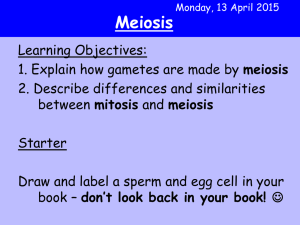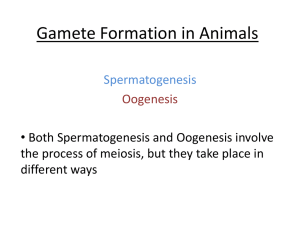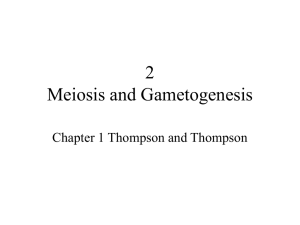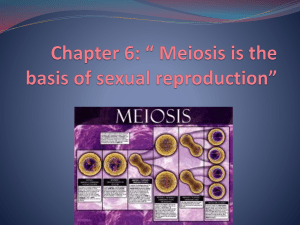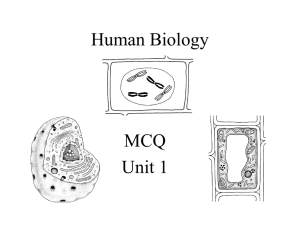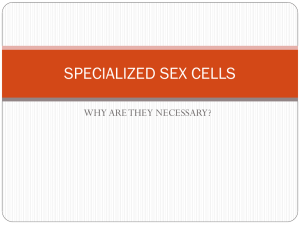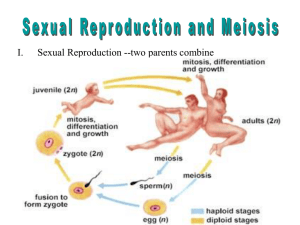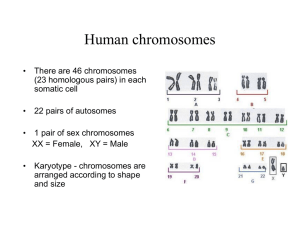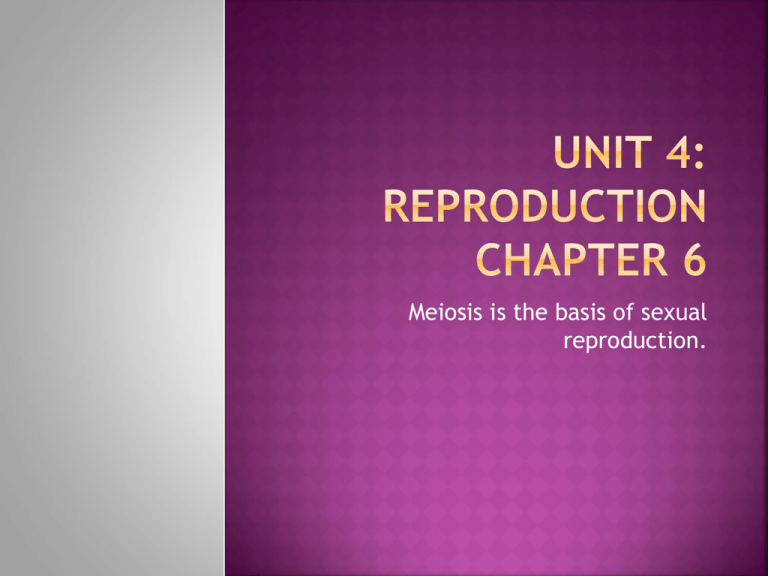
Meiosis is the basis of sexual
reproduction.
Sexual
Reproduction: a method of
reproduction involving two parents,
producing offspring that are genetically
different from each other, either parent, and
from other members of their species.
Sexual reproduction involves uniting specialized cells
called Gametes. In animals, male gametes are called
sperm and female gametes are called eggs.
Fertilization occurs when the gametes unite, with the
sperm penetrating an egg cell.
The process of fertilization results in a cell called a
Zygote. The Zygote undergoes cell division and mitosis
and develops into an Embryo. The embryo grows
continuously to form a new organism.
Diploid number (2n): body cells (all cells excluding sperm and
egg) have two sets of chromosomes. The diploid number for
humans is 46 (2 x 23). Humans inherit one set of 23 from their
male parent and one set of 23 from their female parent.
Haploid number (n): gametes (sperm and egg cells) have only one
set of chromosomes and are termed haploid. Human gametes have
one set of 23 chromosomes. So, the haploid number for humans is
23.
During fertilization, a haploid (n) sperm cell unites with a haploid
(n) egg cell to form a diploid (2n) zygote.
n + n = 2n
Meiosis:
process of producing gametes
(sperm and egg cells) with the haploid (n)
number of chromosomes. Meiosis occurs in
the male and female sex organs (respectively
the testes and ovaries).
Meiosis
involves two rounds of cellular
division:
1. Meiosis I
2. Meiosis II
Homologous
Chromosomes: are pairs of
chromosomes that are the same size,
shape and have genes that are in the
same locations.
Meiosis
1.
2.
3.
4.
I involves:
Prophase I
Metaphase I
Anaphase I
Telophase I
Homologous
chromosomes pair up.
Homologous
equator.
chromosomes pair up at the
Homologous
chromosomes separate and are
pulled towards opposite poles (ends) of the
cell.
Homologous
pairs have moved to opposite
ends of the cell and the cell begins to divide.
Interkinesis:
is the stage between cell
divisions. The cells grow and make various
proteins.
The
end products of Meiosis I are two diploid
(2n) daughter cells.
These cells now go on to enter Meiosis II.
Meiosis
1.
2.
3.
4.
II involves:
Prophase II
Metaphase II
Anaphase II
Telophase II
There
is one chromosome of the homologous
pair in each cell.
Chromosomes
of the cell).
line up at the equator (middle
Half
of each X-shaped chromosome is
pulled apart towards opposite poles
(ends) of the cell.
A
nucleus forms around each set of
chromosomes and the cell begins to divide to
produce 4 gametes.
In
males, after meiosis II, four sperm cells are
formed.
In females, during meiosis, there is an unequal
division of cytoplasm. Following meiosis II, 3 cells
will disintegrate leaving only 1 egg.
Mitosis
Meiosis
Types of Cells
Body Cells
Sex Cells (sperm
and eggs)
Number of
Daughter Cells
produced
2
4
Amount of
Genetic Material
in each daughter
cell
Same number of
chromosomes (2n)
in each cell. Each
daughter cell is
diploid.
Half the number
of chromosomes
(n) in each cell.
Each gamete (sex
cell) is haploid.
Sexual
Sexual
reproduction involves two parents.
Reproduction does not necessarily
require sexual intercourse.
Fertilization
1.
2.
may be:
Internal Fertilization – sperm cells are
deposited inside the female’s body
where they meet an egg cell. Requires
sexual intercourse.
External Fertilization- sperm and egg
cell unite outside the bodies of parents.
This is common in animals that live in
water.
Mosses
•
External fertilization occurs in mosses.
Water is needed to transport gametes, allowing
sperm cells and egg cells to unite.
Male and female sex organs develop on the end
of stems or branches.
Asexual reproduction may also occur by spore
production.
•
•
•
•
•
•
•
Flowering Plants
Internal fertilization occurs in flowering plants.
The process of Pollination occurs. Male gametes are
formed in special cases called Pollen. Pollination is the
transfer of pollen to the female part of the flower.
The male reproductive organ in a flower is called the
Stamen. The female reproductive organ in a flower is
called the Pistil.
Pollination and fertilization occurs at the female
reproductive organ, at the pistil. The pollen lands on
the pistil and sperm are delivered to the egg cells. The
fertilized egg becomes a seed. The seed protects the
developing embryo.
Insects
The
life cycle of insects involves
metamorphosis. Metamorphosis is the
change in an individual's form as it
develops.
Incomplete Metamorphosis: involves subtle
(minor) changes through 3 life cycle stages:
1.
2.
3.
Egg
Nymph (smaller immature version of adult)
Adult
Grasshoppers go through Incomplete Metamorphosis.
Complete Metamorphosis: a change in the form
of an insect as it matures, where the adult is
completely different than the larval stage.
The four common stages of complete metamorphosis, as seen in the
butterfly are:
1.
Egg
2.
Larva (caterpillar)
3.
Pupa
4.
Adult
Asexual
Sexual
1
2
Gametes (eggs or sperm)
None (cell divides)
2 (egg cell and a sperm
cell unite to form a
zygote)
Variation (difference) in
offspring
Lesser (all offspring
identical)
Greater (genetic
diversity)
Amount of Energy
required
Lesser
Greater
Parental care
Lesser
Greater
Mitosis or Meiosis?
Mitosis
Meiosis
# of parent cells
Genetic
conditions that cannot be solved
using current scientific & technological
knowledge include:
1. Down Syndrome
Result of an extra 21st chromosome
Individuals have characteristic facial features
and a shorter stature. They may be prone to
heart defects and other diseases such as
Alzheimer’s and leukemia.
Allderdice Syndrome
2.
Unique to Sandy Point, NL.
An increase in genetic birth defects was
noticed due to geographic isolation.
Result of a mutation on a single maternal
chromosome.
31% chance of developing the syndrome.
3. Cystic Fibrosis
Chronic disease that causes all bodily mucous
to become thick, sticky and difficult to expel.
People with CF are prone to respiratory issues
as well as digestive issues amongst many
others.
Caused by a gene mutation on a single
chromosome. An individual only needs one gene
to prevent it but most people have two (one on
each homologous chromosome). So the
individual must inherit an absence of both
genes to develop disease.
Our
understanding of genetics has changed
over time as new technologies have become
available. New technologies have made it
possible to get a better look at genes and
their influence on traits.
In the mid 1800’s, Gregor Mendel experimented with
inherited traits in pea plants, including color and shape.
Mendel’s studies of pea plants demonstrated that traits
were inherited from one generation to the next.
Mendel’s studies suggested the involvement of “dominant”
and “recessive” factors in the transmission of traits from
parents to offspring. Dominant traits are always expressed,
however recessive traits are not always expressed.
A more clear understanding of genes came about when Francis
Crick and James Watson, described the structure of DNA in 1953.
Crick and Watson showed that DNA is an organization of genes in
a double helix shape, like a twisted ladder. Specific base pairing
on this ladder helped to explain how DNA could replicate (copy
itself). This development also helped to explain how and why
mutations occur.
In
the Human Genome Project, scientists
around the world collaborated for about
20 years to identify every gene in human
DNA, mapping the human genome.
The Human Genome Project made a sort
of map that can be used to search for and
identify particular genes.
The Human Genome Project has provided
information into how and why various
genetic diseases come about.
Genetic
Engineering: is biotechnology that
deals with the manipulation of the genome.
Scientists
have figured out how to cut a gene
out of one DNA strand and place it into
another. The ability to recombine DNA
(recombinant DNA) has made significant
contributions to food and medicine.
Plants and animals have improved through recombinant
DNA technology. Such organisms are labeled as
Genetically Modified Organisms (GMOs). This plays an
important role in the agricultural industry, specifically
crop production.
Genes have been altered to produce plants that are
resistant to colder temperatures, chemicals and
disease.
Genetic engineering has been used to produce
organisms with desired traits.
Scientists use recombinant DNA technology to
produce drugs and provide human gene therapy.
Recombinant DNA technology is being used to
help Diabetes patients, in which the correct
human gene for insulin production, is placed
within the genome of a bacterium. The
bacterium then produces insulin which can be
used as medicine.
Humans who lack a specific gene or who have a
defective gene can have a healthy, functioning
gene inserted into their DNA. This is human gene
therapy.

